UGANDA: 15 Days Birding and Photography plus GORILLA TREK
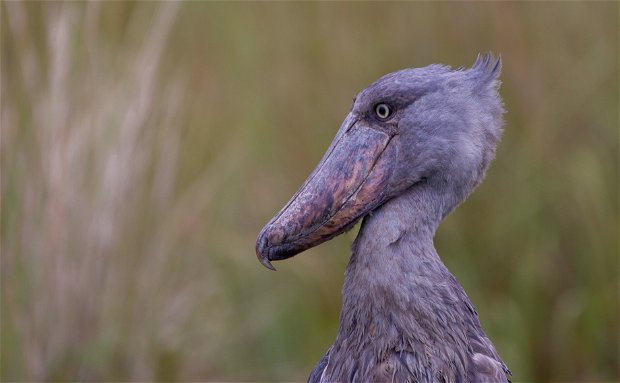
With over 1000 species of birds, Uganda is a must-visit for any birdwatching enthusiast. The Shoebill is one of Africa’s most sought after birds, and Uganda has so much more to offer besides, like the rare Green-breasted Pitta and Grey-winged Robin and many spectacular Albertine Rift endemics. The huge bird list is even more remarkable given the small size of the country making it, arguably, the richest African birding destination.
*Ask to include the Gorilla day-trek on your full day in Bwindi @ 700USD per permit per person
*Two-day add on Chimpanzee trekking available, please inquire
Itinerary tab directly below, next to the gallery tab
Click on days to expand text
Gallery
Itinerary
Click on each day to see daily itinerary & target species
Day 1: Arrival
Day 2: Mabamba Swamp
On our first morning we'll drive to the Mabamba Wetlands and paddle by canoe through the swamp. The Mabamba Swamps west of Entebbe is one of the best and most convenient places to see the elusive Shoebill. After a few minutes in a small canoe the papyrus reeds opens up into a flat grassy wetlands where a number of Shoebill can regularly be seen. Later in the afternoon we'll drive to Masindi/Budongo Forest, a 3 hour trip, where out hotel is located.
Target species: Shoebill Stork, Lesser Jacana, Long–toed Plover, Blue-headed Coucal, Blue breasted Bee-Eater, Papyrus Gonolek, White-winged Warbler, Weyn’s Weaver, Northern Brown-throated Weavers
Day 3: The Royal Mile
Today will be an all-day birding day of the Royal Mile returning to our hotel for lunch. The Royal Mile is found in the 793 km2 Budongo Forest Reserve that lies at the edge of the Albertine Rift and is attached to Murchison Falls National Park in the south. Named for its popularity as a traditional leisure stop-over for Uganda's royalty, the Royal Mile is a superb birding spot with many west and central African species, as well as a variety of sought-after key species.
Target species: White-thighed Hornbill, Blue-breasted Kingfisher, Chocolate-backed Kingfisher, Grey Parrot, Dusky Long-tailed Cuckoo, Nahan’s Francolin, White-breasted Negrofinch, Chestnut-crowned Sparrow-Weaver, Black-bellied Seedcracker, Foxy Cistcola, Red-winged Grey Warbler, Cliff chat, Green-headed sunbird, Chestnut-crowned Sparrow, Dwarf Kingfisher, Yellow-crested Woodpecker and a few primates.
Day 4: Murchison Falls National Park via Kanio Pabidi
Our day starts after breakfast driving to Kanio Pabidi while birding along the road. The Kaniyo Pabidi forest extends over an expanse of approximately 8 km from the Kichumbanyobo gate. Chimpanzee and other primates can often be found foraging through the mahogany trees. A number of special species such as the Yellow-footed Flycatcher, Ituri Batis and the White-thighed Hornbill occur here. It is a 2 to 3 hour trip via Murchison Falls National Park and depending on sightings and we will be arriving late afternoon at and our accommodation for the night.
Target species: Puvell’s Illadopsdis, Rufous-sided Broadbill, Afeb Pigeon, Yellow-billed and Yellow-throated Tinkerbird, Honey guide Greenbul, Red-tailed Ant-thrush, Fire-crested Alethe, Forest Robin, Green Hylia, Grey-throated Tit-Flycatcher, Common Bristlebird, Nahan’s Francolin, Cassin’s Hawk-Eagle, Yellow-footed Flycatcher, Cassin’s Flycatcher, Sabine’s Spinetails
Day 5: Birding in Murchison Falls National Park
We head out for a morning game watching and birding drive returning to the hotel for lunch followed by an afternoon boat ride. Murchison Falls national park has a unique location with several different ecosystems such as the Savannah grasslands, woodlands, rain forests, riverine vegetation, hosting a plethora of bird species.
Target species: Shoebill Stork, Green Pigeon, Vinaceous Dove, White-breasted Turaco, Abyssinian Ground Hornbill, Rock Pratincole, Giant Kingfisher, Swallow tailed bee- eater, Red- throated bee-eater, Carmine bee-eater, Black- billed Barbet, Spotted morning Thrush, Northern Red and black-winged red Bishops
Day 6: Whole day drive
Day 7: Kibale National Park.
Birding in Kibale National Park is a fantastic experience. Kibale National Park and Bigodi Wetland Sanctuary are two prime African birding destinations located in the western part of the country. Created in 1993, Kibale National Park is home to about 350 species of birds, six of which are endemic to the region. Bigodi Wetland Sanctuary, a superb community development enterprise located on the fringe of Kibale National Park in Magombe Swamp is host to 138 species of birds. Our morning birding in the park will continue in the afternoon after returning for lunch back at the hotel and ending at Bigodi Swamp.
Target species: Narina Trogon, Green-breasted Pitta, White-spotted Flufftail, Black-billed Turaco, Blue-throated Roller, White-naped Pigeon, Brown-eared Woodpecker, Red-tailed Ant-Thrush, Yellow-spotted Nicator, Black-and-white Shrike Flycatcher, Chestnut wattle-eye, Green Hylia, Narrow-tailed Starling, Crested Guineafowl, Yellow-billed Barbet
Day 8: Transfer to Semliki National Park
Our day starts with a 2 hour drive to Semliki, birding en-route. The Semliki Basin is considered a mecca for birders. Nowhere else in Africa will you find as many varied habitats. Semliki National Park – the western-most edge of the central Africa rainforest – borders the fabled Mountains of the Moon, the Rwenzori Mountains, with their mist-shrouded forests, and the Semliki Wildlife Reserve which rolls away to one of the Great Lakes of Africa, Lake Albert. All of this is nestled within the walls of the Western rift valley. It can be hot and very humid in the forest, drink plenty of water and take a wet towel with on your walks.
Target species: Rufous-sided Broadbill, Chestnut-flanked Sparrowhawk, Western Bronze-naped Pigeon, Northern Red-billed Hornbill, Piping Hornbill, African Dwarf Kingfishers, White-crested Hornbill, Black Dwarf and Red-billed Dwarf Hornbills
Day 10: Transfer to Queen Elizabeth National Park.
Today we will head to Queen Elizabeth National Park, birding on-route. Having reached Mweya Safari Lodge in the evening, a 3 hour’s drive, we'll bird around the hotel.
Target species: Blue Quail, African Crake, Ross’s Turaco, Jackson’s Pipit, Red-headed Lovebird, White-winged Black Tit, Cassin’s Flycatcher, Black Bee-eater, African white-backed vulture, Eagles, Shining Blue Kingfisher, Cinnamon-chested Bee-Eater, Blue-breasted Kingfisher
Day 9: Full day birding Kirumia Trail
After early morning breakfast where after we proceed to Kirumia Trail for a full day birding. We will take along a packed lunch today. The birding at Semliki is as challenging as it is rewarding. The Kirumia Trail winds from the road for approximately 16 km to Semliki River, passing through ironwood-dominated forest, swamp forest, and overgrown cultivation.
Target species: Black-casqued Wattled Hornbill, Nkurengu Rail, Spot-breasted Ibis, Forest Francolin, Long-tailed Hawk, Red-billed Dwarf Hornbill, Black-wattled Hornbill
Day 11: Birding in Queen Elizabeth National Park
Our day starts with an early morning's game viewing and birding drive. Lunch will be back at the lodge with a boat trip in the afternoon on the Kazinga Channel. Along the channel we will encounter a variety of wildlife as well as hundreds of hippos and crocodiles. Elephants, Buffaloes, Uganda Kobs, Bushbucks, Defassa Waterbucks and Warthogs also occur here. The Queen Elizabeth Park is classified as an Important Birding Area (IBA) by Birding International. The great variety of habitats mean it is home to over 600 species. This is the greatest of any East African national park, and a phenomenal number for such a small area. Present in the park are numerous water birds, woodland and forest dwellers in the Maramagambo Forest, 54 raptors and various migratory species.
Target species: Martial Eagle, Black-rumped Buttonquail, African Skimmer, Chapin’s Flycatcher, Pink-backed Pelican, African Broadbill, Verreaux’s Eagle Owl, Black Bee-eater, White-tailed Lark, White-winged Warbler, Papyrus Gonolek, Papyrus Canary, Corncrake, Lesser and Greater Flamingo, Shoebill, Bar-tailed Godwit.
Day 12: Transfer to Bwindi - Buhoma-sector via Ishasha
After breakfast you will be transfered to Bwindi National Park via Ishasha. It is a 5 to 6 hour drive and we will have lunch en-route. At Ishasha our game viewing includes searching for the famous tree climbing Lions. The park is an excellent place for good bird and wildlife photography. We'll have an afternoon birding walk around the Buhoma area in search of our main target species, Black-and-white Mannikin.
Day 13: Bwindi National Park & Gorilla Trek
The Bwindi National Park covers an area of 321 square km and is located in the south west of Uganda along the border with the Democratic Republic of Congo. This birding spot is home to over 320 bird species, making 23 of these species endemic to the area. Our birding will take us along the main park trail where we will search for a variety of species both in the morning and afternoon. If you want to take advantage of including the Gorilla Trekking for today please let us know well in advance as limited permits are issued by the Uganda parks board at an additional 700USD/person.
Target species: African Goshawk, Bar-tailed trogon, Black Bee-Eater, Mountain Illadopsis, Red-faced woodland Warbler, Yellow-footed Flycatcher, White-tailed Blue Flycatcher, White headed Wood-hoopoe, Chapin’s Flycatcher, Pink-footed puff back, Bush Shrike, Starlings, Brown-capped weavers, Blue-throated Roller, Willcocks’s Honeyguide, Elliot's Woodpecker
Day 14: Transfer to Lake Mburo National Park.
After an early morning breakfast we will transfer to Lake Mburo National Park. It is a 5 to 6 hour drive with several birding stops en-route. This is the closest game park to Kampala city; it is located in a series of swamp-fringed lakes which provide a great habitat for bird life, notably the secretive African Finfoot and the Red-faced Barbet. Lake Mburo national park is a well developed Acacia woodland harboring great species of birds. It has a great number of savannah species of birds and is the best place in Uganda to view the typical savannah bird species. The park has about 313 different bird species including 8 of the 12 species of the Lake Victoria Basin biome that occur in Uganda
Target species: Shoebill stork, White-winged Warbler, Crested, Coqui and Red-winged Francolins, Blue-spotted Wood Dove, Brown Parrot, Barefaced Go-away bird, Harlequin and Blue Quails, Common Button Quail, White-headed and Black-billed Barbet, Green wood-hoopoe, Common Scimitarbill, Blue-napped Mousebird, Blue-breasted and Shining-blue Kingfishers, Lilac-breasted Roller, African-grey Hornbill, the Nubian, Buff-spotted, Brown-eared, and the Grey Woodpeckers, Trilling- , Stout- , and Wing-snapping Cisticolas, Red-necked Spurfowl, Black-bellied Bustard, Temminck’s Courser, African-wattled Plover, Rufous napped Lark, Flappet larks, Rufous-chested Swallow ,Yellow-throated Longclaw, Black-winged Bishop, Chubb’s, Carruther’s Warbler, Lesser and Great Swamp Warbler
Day 15: Early morning birding and transfer to Kampala.
Our day will start with an early morning boat ride on Lake Mburo in search of, among others, the African Finfoot. Lunch will be at the hotel and later in the day we will drive to Kampala and transfer to Entebbe and the end of the trip. Depending on your flight time you may opt to fly out tonight or book an extra night for your flight the following day.
Target species: Red-faced Barbet (range restricted to a small area in Southern Uganda and Eastern Rwanda), Southern Ground Hornbill, Spot-flanked Barbet, Black-collared Barbet, Blue-naped Mousebird, White-winged Warbler, Papyrus Gonolek, Violet tipped Courser, Northern Brown-throated Weaver
Rates
Inquire for custom dates
Best birding seasons:
June to mid-September
December to early April
Please inquire for rates
Included: 14 nights' accommodation, meals, transport in a 5-seater long-base safari Jeep for up to 4 pax and minibus for up to 6 pax, specialist guides, activities mentioned, park and entrance fees, bird list, water in vehicle
Excluded: Flights, Travel and medical insurance, alcoholic beverages, guide tips, Gorilla trek additional 700USD/person depending on availability of permits
Note on visas:
1. an online e-visa has to be applied for before arrival
2. a yellow-fever vaccinations certificate is compulsory to enter the country



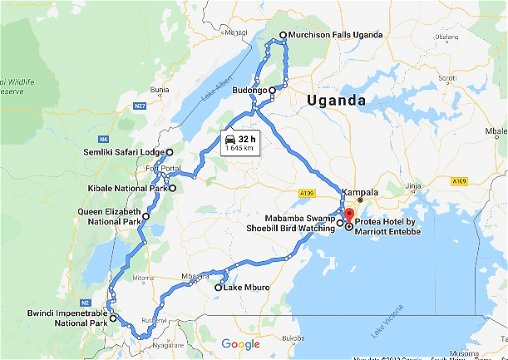
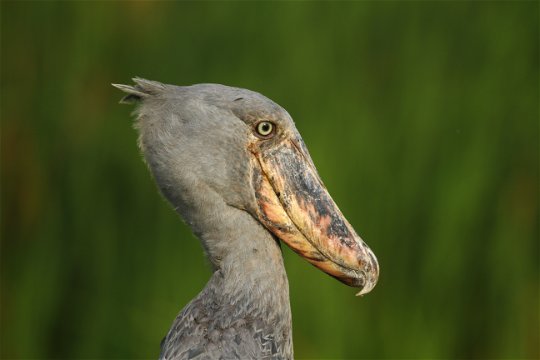
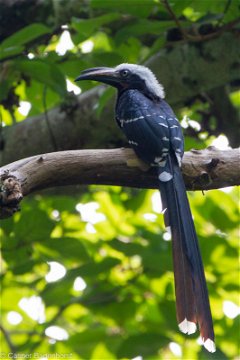

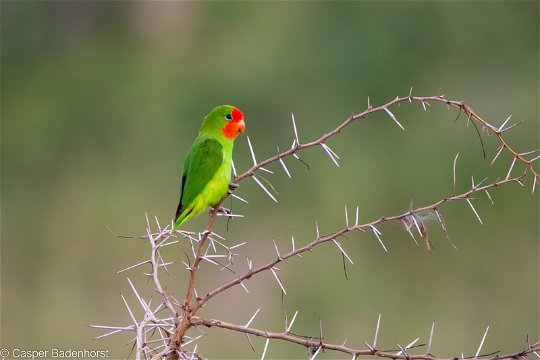


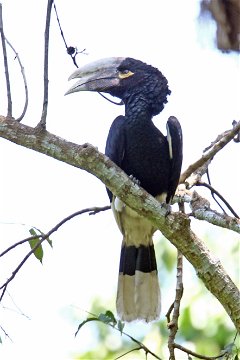


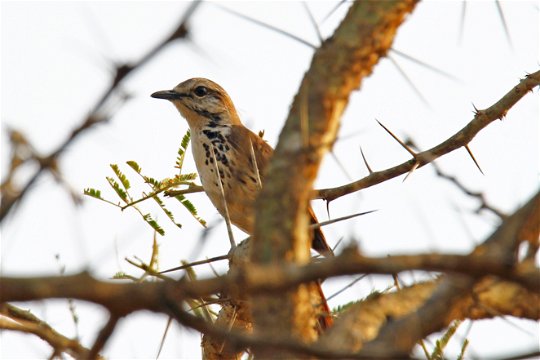


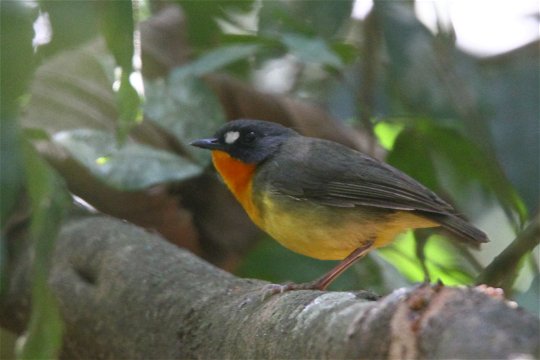
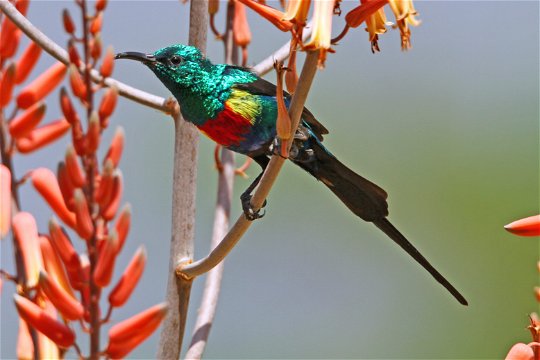
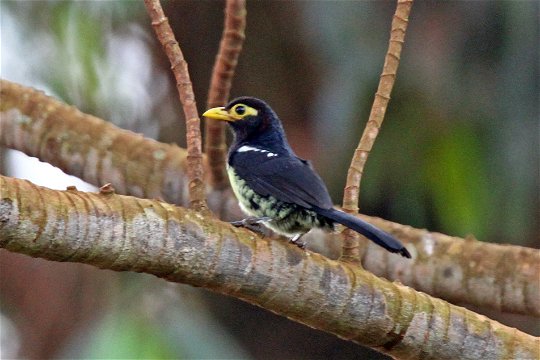
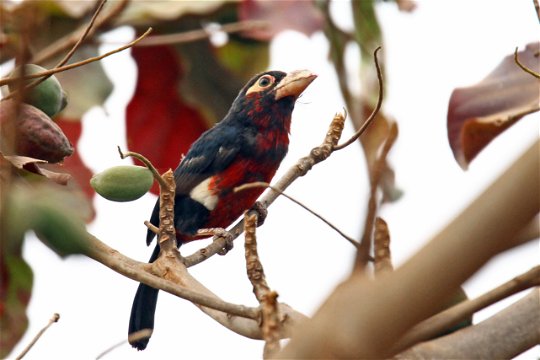
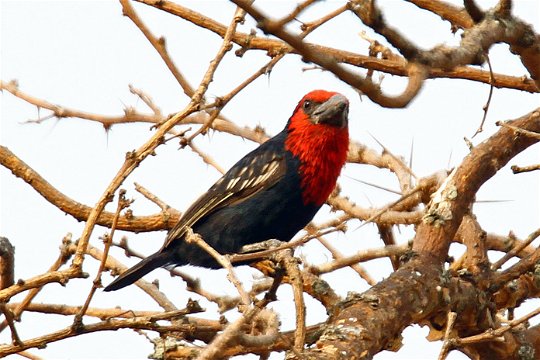

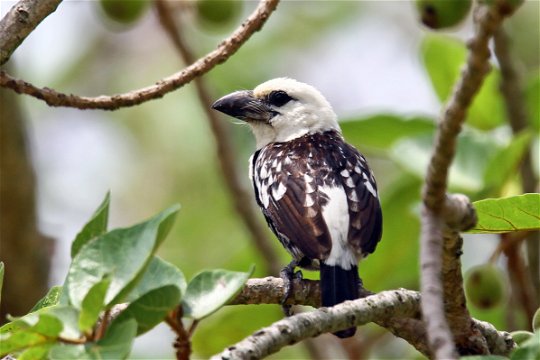

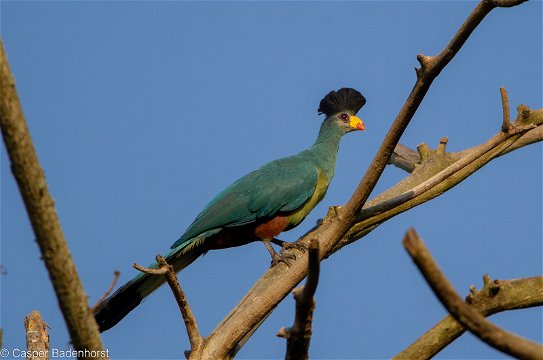

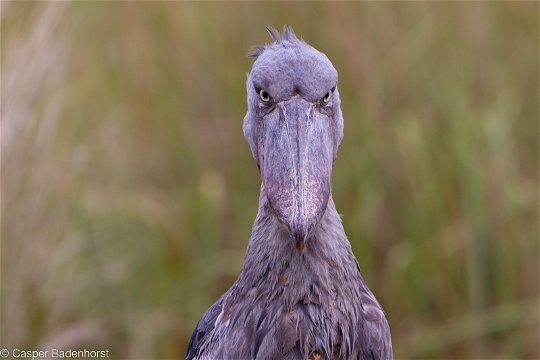
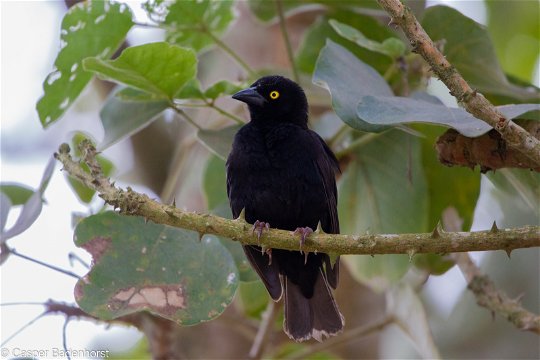

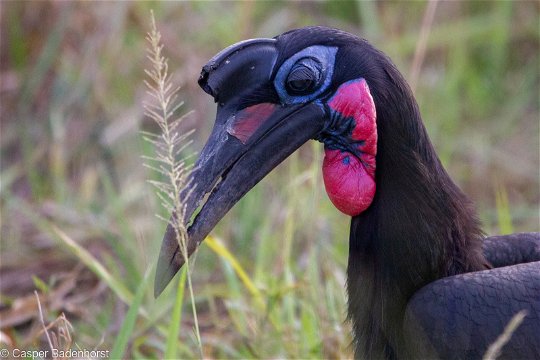


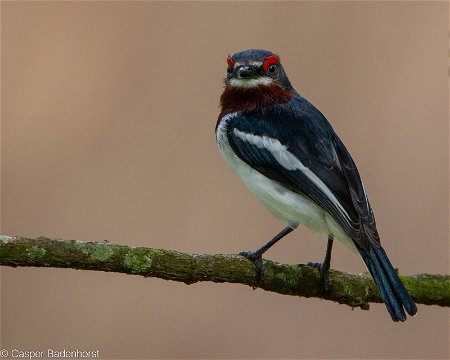
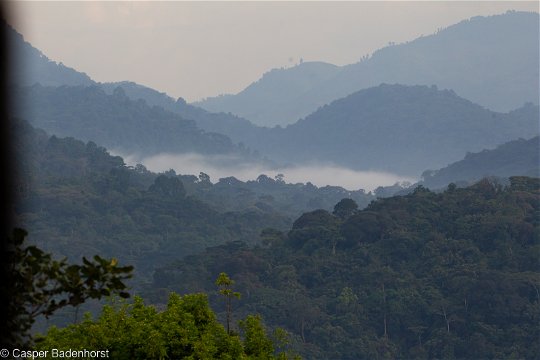
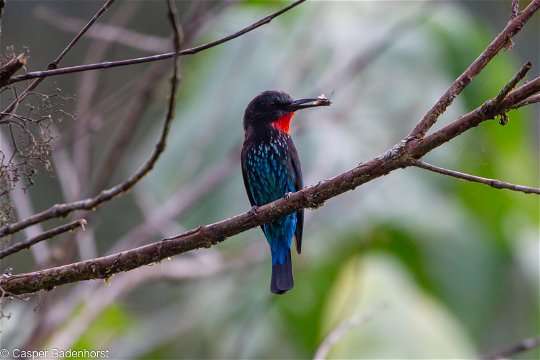


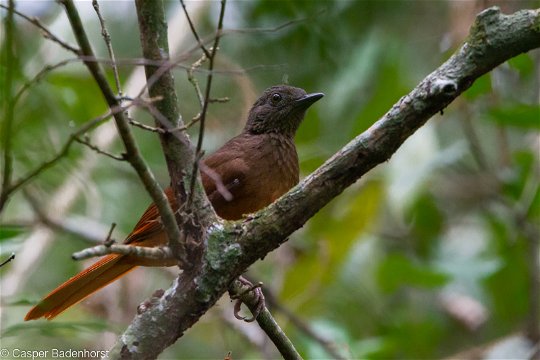
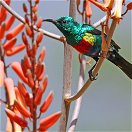
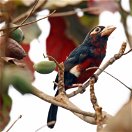
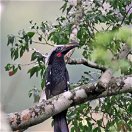
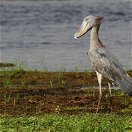
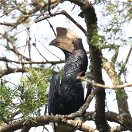
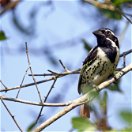

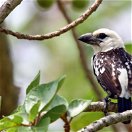
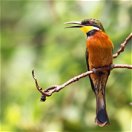



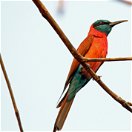

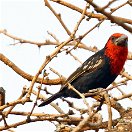
Share This Page